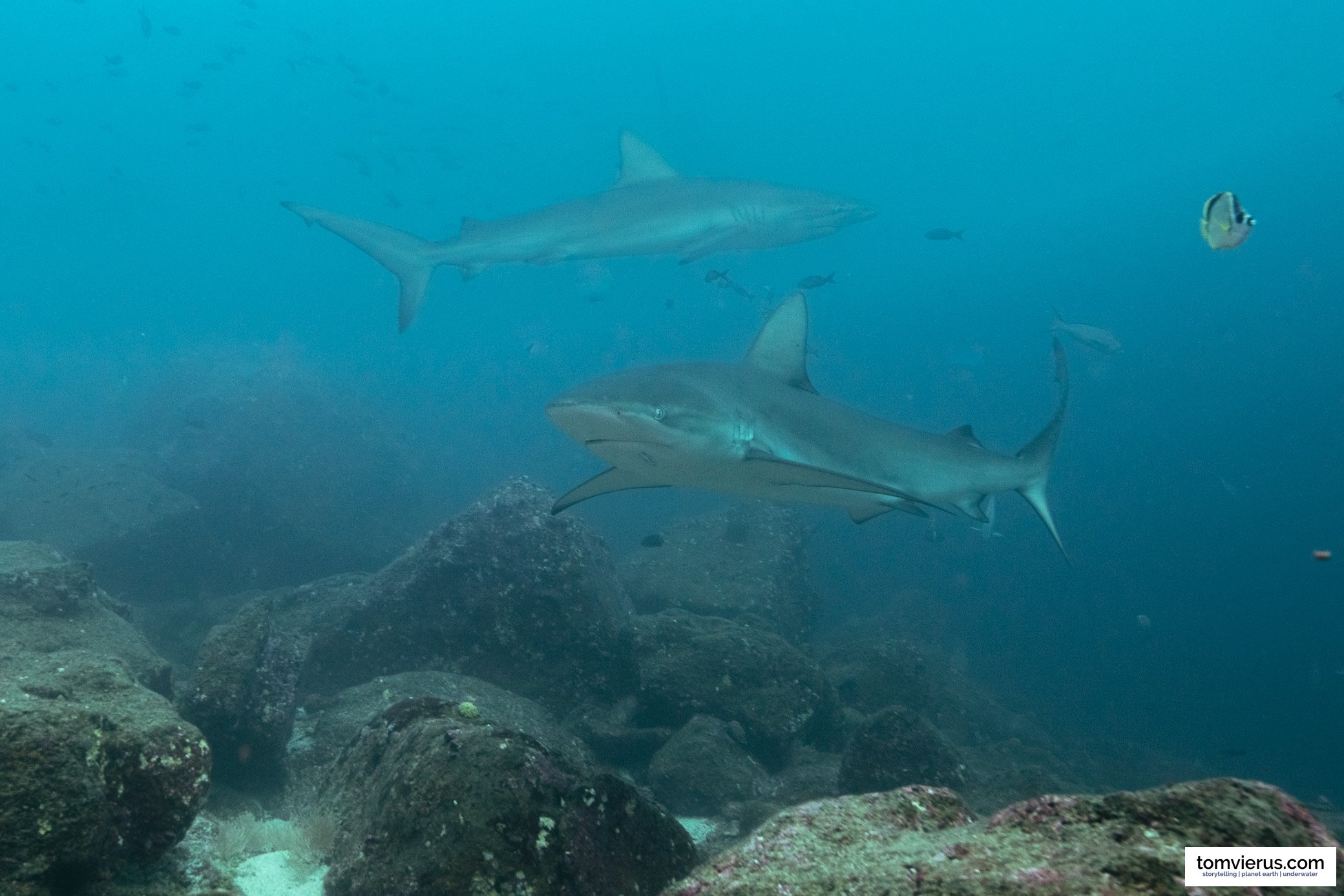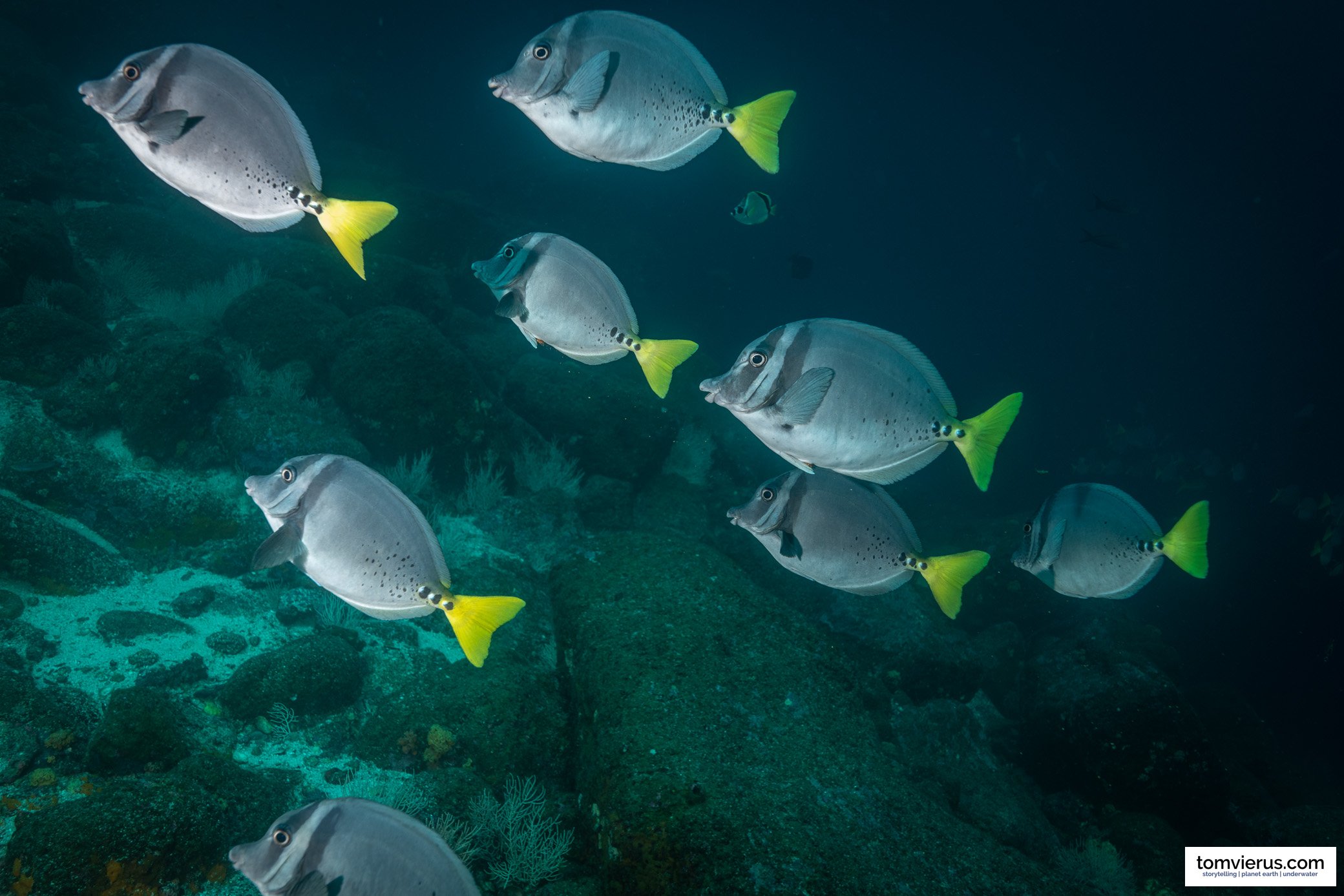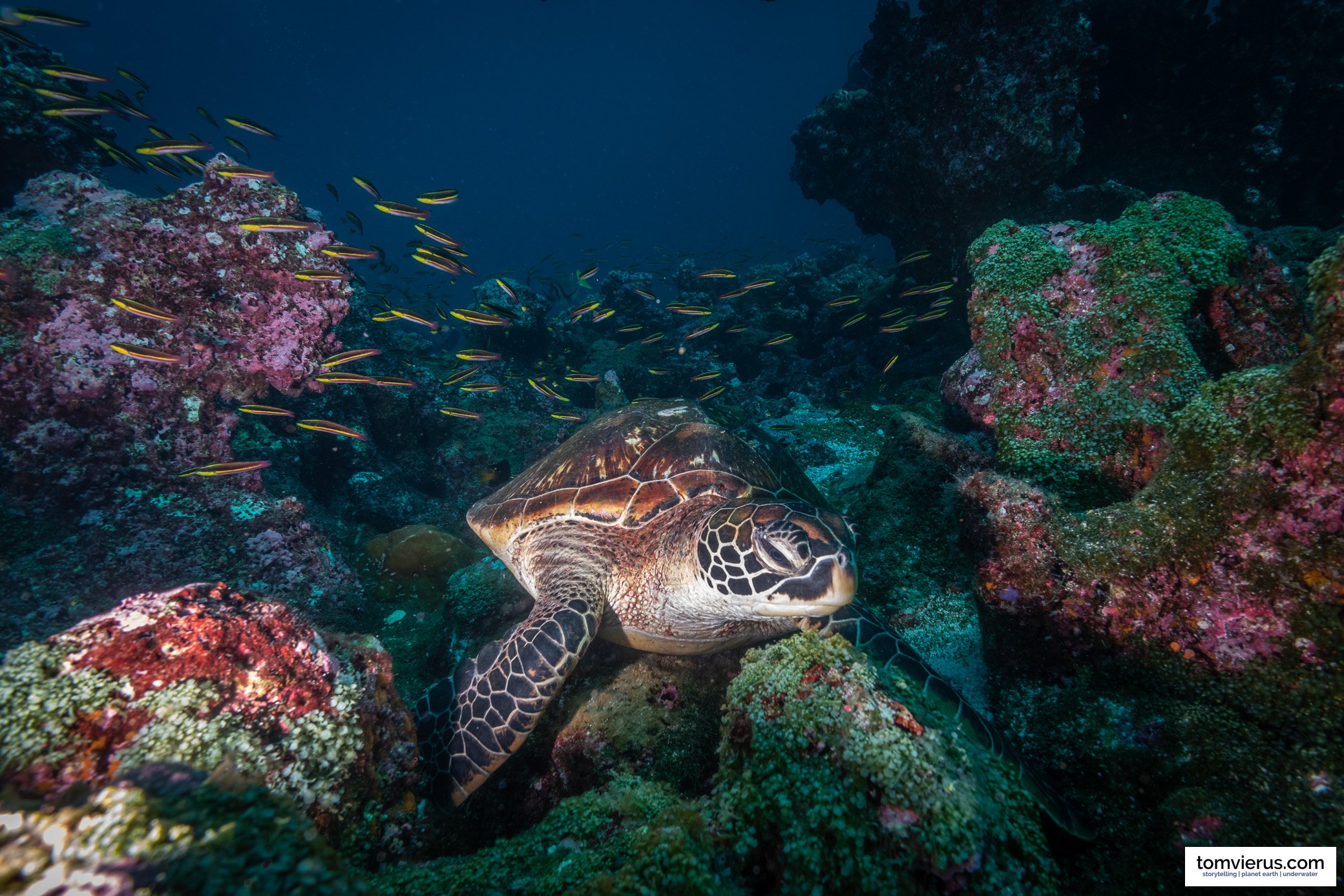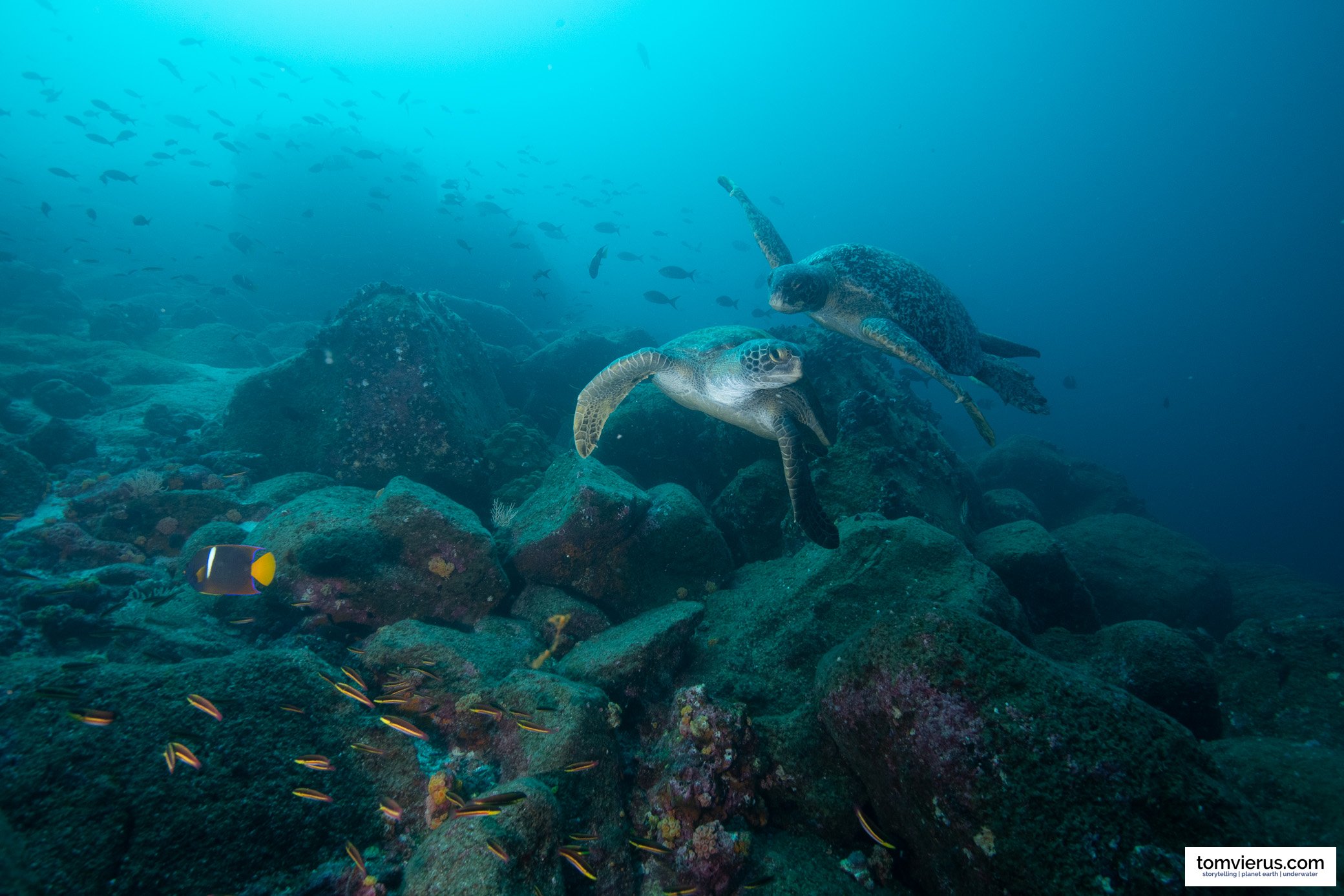Galápagos Diving from a Photography Perspective | Darwin's Arch | Part 3
This series of posts is about an 11-day liveaboard trip throughout the Galápagos Islands aboard the Deep Blue with the Master Liveaboard Fleet. Having shot several thousand images, I thought I would share a few more here than on my other social channels, but be sure to check out my Instagram, TikTok, Youtube, and Twitter for more. This part is about the first-day diving at the legendary Darwin's Arch. Have a look at the other posts in this series.
When I woke up the next morning, it was shortly past 5 pm, and I headed straight back out of the cabin to not wake my cabin mate. I grabbed a coffee and went on the roof to enjoy the sight: the famous Darwin's Arch. It was a little surreal to be actually laying my eyes on this iconic rock formation that I had seen so many times in dive videos or documentaries.
And the best about it was that I was actually going to dive here for the next two days. I felt really happy and blessed at that point. After a moment of life appreciation, I headed back down and finished setting up my camera for the day: make sure an empty 128 GB SD Card was in the camera, exchange all eight batteries for the two Inon strobes, make sure the camera battery was fully charged as well as the Kraken Hydra 15000 batteries (which are insanely large!).
The famous Darwin’s Arch photographed from the water. The famous rock formation collapsed due to erosion in mid-2021.
A group of young boobies rest on our boat and enjoy the sight of Darwin’s Arch in the background.
After breakfast, it was time for the first dive. We anchored just off Darwin Island, a few hundred meters away from the actual dive site at the arch, and needed a good ten minutes with the pangas to get to the site. Once right next to it, Juan counted down from 3, and we all did the typical backroll entry. Before I could even realise what was happening, I heard Juan frantically rattling his rattler, and that could only mean one thing: whale shark! During the briefings, it was made clear that the rattler is only used to either get the attention of a diver (one ratttle), to descend down and stay or to leave a spot (three rattles) and whale shark sighting (continuous rattling).
A typical sight during a dive at Darwin’s Arch in the northern part of the Galapagos Archipelago. A diver rests at the edge of a rock plateau, looking into the blue and waiting for animals to swim by.
A large whale shark passes overhead a group of divers at Darwin’s Arch, Galapagos Archipelago.
A scalloped hammerhead shark in the distance photographed in rather murky waters.
Two Galapagos sharks (Carcharhinus galapagensis) encountered during a dive at Darwin’s Arch in the northern part of the Galapagos Archipelago. Despite the name, these sharks are found worldwide.
I made the beginner mistake of not having set my camera at a good 'all kind of situation' setting, e.g. a shutter speed of 1/200 sec, aperture of eight and Auto ISO plus the strobes on medium power, and thus wasn't really ready. If you have seen a whale shark swimming, you know they are fast despite barely moving the caudal fin, and it was the same here.
We almost jumped right on top of this whale shark, and it passed us mere seconds after descending right above our heads. It was gigantic and really appeared like a large school bus underwater. I snapped a few images before it had moved on, and we continued our dive towards the edge of the platform that surrounds Darwin's Arch. Similar to the dives around Wolf Island, we'd spend a lot of time just waiting behind boulders and looking out in the blue, hoping for rays, sharks, schools of fish and - you guessed it - more whale sharks.
A Green Sea Turtle (Chelonia mydas) passes by a diver using a reef hook to stay stable in the current.
A group of Sawtail Surgeonfishes (Genus Prionurus).
Finally diving Darwin's Arch!
Many scalloped hammerhead sharks passed by, but often they’d be too far away to shoot decent photographs.
Portrait image of a Galapagos shark (Carcharhinus galapagensis) encountered at Darwin’s Arch, Galapagos Archipelago.
A scalloped hammerhead shark (Sphyrna lewini).
A Green Sea Turtle (Chelonia mydas) resting surrounded by small reef fish rests in between small rocks at Darwin’s Arch, northern Galapagos Archipelago.
Portrait of a Redlip Parrotfish (Scarus rubroviolaceus) encountered in the shallows.
A school of Bigeye Trevallies (Caranx sexfasciatus).
One of our dive guides points at the large scar on top of this whale shark, likely due to a ship propeller impact.
A seemingly pregnant female whale shark (Rhincodon typus) passes in the waters surrounding Darwin’s Arch in the northern part of the Galapagos Archipelago. Most animals seen here are females and often pregnant; scientists believe these whale sharks may be giving birth in this area.
A female whale shark (Rhincodon typus) in black and white.
A scalloped hammerhead shark (Sphyrna lewini) passes by at Darwin’s Arch in the northern part of the Galapagos Archipelago.
A scalloped hammerhead shark (Sphyrna lewini).
A scalloped hammerhead shark (Sphyrna lewini) – how cool are these sharks?
The collapsed Darwin’s Arch as seen from the water after ascending from a dive there.
Two Green Sea Turtle (Chelonia mydas) courting at Darwin’s Arch – there was definitely a lot of turtle love in the water!
We made our way along the rocky plateau to the edge, where we all deflated our BCDs and set up in a line. Everyone was responsible for finding their own place and preferably not too close together. I did the same as in WOlf - I situated myself down current and slightly deeper than the rest of the group. The sharks would be swimming against the current, and thus, I would be the first diver they would encounter - at least if they came perfectly parallel to where we were sitting, which wasn't always the case.
I didn't take long, and we saw a few hammerheads but rather in the distance, and some of the surprisingly large Galapagos sharks came to check me up, allowing me to take a few great portrait shots of this new shark species for my portfolio. After we had spent some time at some of the spots and couldn't detect too much activity, we'd normally move on, drift with the current before either waiting at another location or drifting - if the current was right - along and almost all the way to our boat anchored at Wolf Island. Although we had some current over the day, it wasn't very strong and coupled with the not-so-great visibility, I almost felt disappointed. But then I reminded myself that just because the water wasn't crystal clear, any of the dives we were doing would easily be a dive, which would make a dive holiday in most locations! It is all about managing expectations, I thought to myself.
Despite the conditions, I ended up shooting so many cool photos and not forgetting the actual experience of witnessing all this abundance and variety of life with my own eyes.. It was actually insane. At one point, we were all drifting through the blue, which can be a pretty crazy experience. There are no points of reference whatsoever (other than the other dives), and it is important to keep checking the dive computer to make sure you are not sinking or rising, which one might not necessarily feel. It was diving on the outer left side of the group, scanning the blue for activity when a large shadow appeared. I knew instantly it was another whale shark: I shouted through my regulator to make the rest of the crew aware and started swimming towards it.
It was coming my way, but not directly at me, so I tried to fin it as fast as I could towards its head and snapped a few photos. Geoff, our dive guide for that particular dive, was suddenly next to me, kicking his freediving fins through the water and making some good headway. I repeatedly pointed towards a large scar on the back of the head of the whale shark and asked me to take photos of it. These kinds of photos can help to identify individuals and support the whale shark science that is carried out here in the Galapagos Islands. What an epic encounter and the second whale shark for the day (for myself).
The rest of the crew had also seen another whale shark, but since I was too far away and generally not able to kick as fast as most others with the large underwater housing, I didn't even try to fin all the way to the rattle and waste a lot of air in the process. Two was good for me :) All four dives that day were pretty amazing, and to top it off, I finally managed to get close and personal with some scalloped hammerhead sharks, my favourite of all. As mentioned in the post about diving at Wolf Island, it is hard to have them come close when on scuba gear as they just don't like the bubbles.
But the few great photos I was able to capture were all shot the same way: crouching behind a large rock as far away from the group as possible (while still having visual contact with them), holding your breath while the shark is approaching and snap as many photos as you can when you have to breath (and release bubbles which will likely scare the individual(s) off.
What an amazing animal - just look at it! What a day of diving it was! After a deco beer and downloading my images, and charging my batteries, I feel happy and exhausted into bed. And the cool part was I got to do it all again tomorrow. Another four dives at Darwin, and who knew what this beautiful place would have in store for us..






















